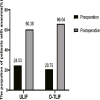Comparison of the total and hidden blood loss in patients undergoing single-level open and unilateral biportal endoscopic transforaminal lumbar interbody fusion: a retrospective case control study
- PMID: 37060012
- PMCID: PMC10103431
- DOI: 10.1186/s12891-023-06393-y
Comparison of the total and hidden blood loss in patients undergoing single-level open and unilateral biportal endoscopic transforaminal lumbar interbody fusion: a retrospective case control study
Abstract
Purpose: This study aimed to compare total blood loss (TBL) and hidden blood loss (HBL) in patients undergoing single-level open transforaminal lumbar interbody fusion (O-TLIF) and unilateral biportal endoscopic transforaminal lumbar interbody fusion (ULIF).
Methods: A total of 53 patients who underwent ULIF and 53 patients who underwent O-TLIF from March 2020 to July 2022 were retrospectively reviewed. The Nadler's formula was employed to estimate the patient's blood volume (PBV), Gross's formula to estimate TBL, and Sehat's formula to estimate HBL. The obtained data were then analyzed with independent t test, chi-squared test, and analysis of covariance.
Results: TBL and measured blood loss (MBL) in ULIF group (326.86 ± 223.45 ml, 99.00 ± 72.81 ml) was significantly lower than O-TLIF group (427.97 ± 280.52 ml, 270.66 ± 102.34 ml). Nevertheless, the HBL in ULIF group was higher than that in O-TLIF group (227.86 ± 221.75 ml vs 157.31 ± 268.08 ml), however this was not statistically significant (p = 0.143). The HBL was 69.71 ± 23.72% of TBL in ULIF group and 36.76 ± 18.79% of TBL in O-TLIF group. Patients in ULIF group had lower TBL and MBL, shorter duration of drainage, lower postoperative anemia, and shorter postoperative hospital stay compared to those in O-TLIF group.
Conclusions: Perioperative HBL should not be neglected in patients undergoing ULIF or O-TILF, as it accounts for a large percentage of TBL in both groups. ULIF is associated with lower TBL and MBL, postoperative anemia, shorter postoperative hospital stays compared with O-TLIF.
Keywords: Degenerative lumbar disease; Hidden blood loss; Total blood loss; Transforaminal lumbar interbody fusion; Unilateral biportal endoscopy.
© 2023. The Author(s).
Conflict of interest statement
The authors declare no competing interests.
Figures




Similar articles
-
Comparison of the Total and Hidden Blood Loss in Patients Undergoing Open and Minimally Invasive Transforaminal Lumbar Interbody Fusion.World Neurosurg. 2017 Nov;107:739-743. doi: 10.1016/j.wneu.2017.08.113. Epub 2017 Aug 24. World Neurosurg. 2017. PMID: 28844914
-
Unilateral biportal endoscopic lumbar interbody fusion (ULIF) versus minimally invasive transforaminal lumbar interbody fusion (MI-TLIF) for the treatment of degenerative lumbar spondylolisthesis: a retrospective analysis.BMC Musculoskelet Disord. 2025 May 28;26(1):526. doi: 10.1186/s12891-025-08777-8. BMC Musculoskelet Disord. 2025. PMID: 40437446 Free PMC article.
-
Unilateral biportal endoscopic lumbar interbody fusion (ULIF) versus endoscopic transforaminal lumbar interbody fusion (Endo-TLIF) in the treatment of lumbar spinal stenosis along with intervertebral disc herniation: a retrospective analysis.BMC Musculoskelet Disord. 2024 Feb 29;25(1):186. doi: 10.1186/s12891-024-07287-3. BMC Musculoskelet Disord. 2024. PMID: 38424576 Free PMC article.
-
Unilateral biportal endoscopic lumbar interbody fusion versus minimally invasive transforaminal lumbar interbody fusion for single-segment lumbar degenerative disease: a meta-analysis.BMC Musculoskelet Disord. 2024 Nov 21;25(1):938. doi: 10.1186/s12891-024-08046-0. BMC Musculoskelet Disord. 2024. PMID: 39574056 Free PMC article.
-
Unilateral biportal endoscopic lumbar interbody fusion enhanced the recovery of patients with the lumbar degenerative disease compared with the conventional posterior procedures: A systematic review and meta-analysis.Front Neurol. 2023 Jan 10;13:1089981. doi: 10.3389/fneur.2022.1089981. eCollection 2022. Front Neurol. 2023. PMID: 36703632 Free PMC article.
Cited by
-
A systematic review of biportal endoscopic spinal surgery with interbody fusion.Asian Spine J. 2025 Apr;19(2):275-291. doi: 10.31616/asj.2024.0425. Epub 2025 Apr 7. Asian Spine J. 2025. PMID: 40195641 Free PMC article.
-
A retrospective study on safety and clinical outcomes of unilateral biportal endoscopic technique for spinal degenerative diseases.PeerJ. 2025 Apr 3;13:e19076. doi: 10.7717/peerj.19076. eCollection 2025. PeerJ. 2025. PMID: 40191755 Free PMC article.
-
Clinical comparison of percutaneous endoscopic interlaminar vs. unilateral biportal endoscopic discectomy for lumbar disc herniation: a retrospective study.Sci Rep. 2025 May 2;15(1):15347. doi: 10.1038/s41598-025-99959-w. Sci Rep. 2025. PMID: 40316768 Free PMC article.
-
Utilizing MRI and CT to identify risk factors associated with cage subsidence.Eur J Med Res. 2025 Jul 1;30(1):529. doi: 10.1186/s40001-025-02797-9. Eur J Med Res. 2025. PMID: 40598416 Free PMC article.
-
Risk factors for hidden blood loss in unilateral biportal endoscopic lumbar interbody fusion : a single-center retrospective study.BMC Musculoskelet Disord. 2024 Dec 18;25(1):1017. doi: 10.1186/s12891-024-08104-7. BMC Musculoskelet Disord. 2024. PMID: 39695594 Free PMC article.
References
MeSH terms
Grants and funding
- 81902239/National Natural Science Foundation of China
- 82002345/National Natural Science Foundation of China
- 81971036/National Natural Science Foundation of China
- KJXW2019011/Science and Technology Project of Suzhou
- SDFEYBS1905/Preliminary Research Project of the Second Affiliated Hospital of Soochow University
LinkOut - more resources
Full Text Sources
Research Materials
Miscellaneous

